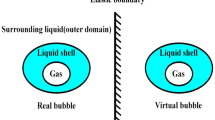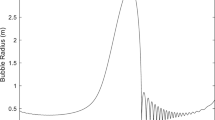Abstract
In many industrial and medical systems, there is a bubble between two elastic walls. On the other hand, the collapse of bubbles is considered a constant source of energy lost and causes system damage. This research is the first attempt to prevent from bubble collapse between two elastic boundaries by using control algorithms. In this paper, first, the nonlinear dynamic model of the bubble between two elastic walls is introduced and then rewritten into a state-space form. The second part of this paper is devoted to the design of the sliding mode controller, where the ultrasonic pressure plays the role of control input and the output is bubble radius. At first, terminal sliding mode control is proposed. Although this method ensures finite-time convergence, its main drawback is singularity in the control input signal. The nonsingular terminal sliding mode control is proposed to solve the problem of singularity in the control input signal. A rigorous stability analysis is also presented using the Lyapunov theory to demonstrate the stability of nonsingular sliding manifold. The effect of controller parameters on the performance of the closed-loop system is investigated. Finally, some simulation results including the case of parametric uncertainty are also presented to demonstrate the efficiency of the proposed scheme. The results of this study are of immediate interest for industrial applications such as designing pumps and valves and medical applications such as targeted ultrasound imaging and cancer treatment.

















Similar content being viewed by others
References
Abe, Y., Kawaji, M., & Watanabe, T. (2002). Study on the bubble motion control by ultrasonic wave. Experimental Thermal and Fluid Science,26(6–7), 817–826.
Alsmadi, Y. M., Utkin, V., Haj-Ahmed, M., Xu, L., & Abdelaziz, A. Y. (2018). Sliding-mode control of power converters: AC/DC converters and DC/AC inverters. International Journal of Control,91(11), 2573–2587.
Badfar, E., & Ardestani, M. A. (2019a). Robust versus optimal control for the radius of spherical bubble in a perfect incompressible liquid, LMI optimization approach. International Journal of Dynamics and Control. https://doi.org/10.1007/s40435-019-00586-x.
Badfar, E., & Ardestani, M. A. (2019b). Utilizing sliding mode control for the cavitation phenomenon and using the obtaining result in modern medicine. SN Applied Sciences,1(11), 1419.
Böhm, L., Brehmer, M., & Kraume, M. (2016). Comparison of the single bubble ascent in a Newtonian and a non-Newtonian liquid: A phenomenological PIV study. Chemie Ingenieur Technik,88(1–2), 93–106.
Brennen, C. E. (2014). Cavitation and bubble dynamics. Cambridge: Cambridge University Press.
Davis, J. A., & Stewart, M. (2002). Predicting globe control valve performance—Part I: CFD modeling. Journal of Fluids Engineering,124(3), 772–777.
Doinikov, A. A. (2001). Translational motion of two interacting bubbles in a strong acoustic field. Physical Review E,64(2), 026301.
Doinikov, A. A., Aired, L., & Bouakaz, A. (2011a). Acoustic response from a bubble pulsating near a fluid layer of finite density and thickness. The Journal of the Acoustical Society of America,129(2), 616–621.
Doinikov, A. A., Aired, L., & Bouakaz, A. (2011b). Acoustic scattering from a contrast agent microbubble near an elastic wall of finite thickness. Physics in Medicine & Biology,56(21), 6951.
Doinikov, A. A., Novell, A., & Bouakaz, A. (2012). Dynamics of a contrast microbubble between two elastic walls. In 2012 IEEE International ultrasonics symposium. IEEE.
Doinikov, A. A., Zhao, S., & Dayton, P. A. (2009). Modeling of the acoustic response from contrast agent microbubbles near a rigid wall. Ultrasonics,49(2), 195–201.
Feng, Y., Yu, X., & Han, F. (2013). On nonsingular terminal sliding-mode control of nonlinear systems. Automatica,49(6), 1715–1722.
Hegedűs, F., & Kalmár, C. (2018). Dynamic stabilization of an asymmetric nonlinear bubble oscillator. Nonlinear Dynamics,94(1), 307–324.
Hui, L., & Li, J. (2009). Terminal sliding mode control for spacecraft formation flying. IEEE Transactions on Aerospace and Electronic Systems,45(3), 835–846.
Kang, C., Zhang, W., Zou, Z.-W., & Pang, C.-B. (2018). Effects of initial bubble size on geometric and motion characteristics of bubble released in water. Journal of Central South University,25(12), 3021–3032.
Li, S., Zhou, M., & Yu, X. (2013). Design and implementation of terminal sliding mode control method for PMSM speed regulation system. IEEE Transactions on Industrial Informatics,9(4), 1879–1891.
Lindner, J. R. (2004). Microbubbles in medical imaging: Current applications and future directions. Nature Reviews Drug Discovery,3(6), 527.
Meyer, K., Wiesmann, M., Albers, T., & Seidel, G. (2003). Harmonic imaging in acute stroke: Detection of a cerebral perfusion deficit with ultrasound and perfusion MRI. Journal of Neuroimaging,13(2), 166–168.
Multiphysics, C. (2014). Fluid structure interaction in a network of blood vessels. In Structural mechanics module model library manual (Vol. 1).
Mulvagh, S. L., DeMaria, A. N., Feinstein, S. B., Burns, P. N., Kaul, S., Miller, J. G., et al. (2000). Contrast echocardiography: Current and future applications. Journal of the American Society of Echocardiography,13(4), 331–342.
Najafi, M., Azadegan, M., & Beheshti, M. T. (2016). Stability analysis and sliding mode control of a single spherical bubble dynamics. In 2016 American control conference (ACC). IEEE.
Najafi, M., Rahni, M. T., Massah, H. R., & Mokhtari-Wernosfaderani, Z., & Daemi, M. (2016). Approximate analytical solution via ADM and numerical simulation of acoustic cavitation: Bubble dynamics. In M. Najafi (Eds.), Progress in colloid and interface science (pp. 413–430). New York: CRC; Taylor & Francis.
Overvelde, M., Garbin, V., Sijl, J., Dollet, B., De Jong, N., Lohse, D., et al. (2010). Nonlinear shell behavior of phospholipid-coated microbubbles. Ultrasound in Medicine and Biology,36(12), 2080–2092.
Qi, L., & Shi, H. (2013). Adaptive position tracking control of permanent magnet synchronous motor based on RBF fast terminal sliding mode control. Neurocomputing,115, 23–30.
Sankin, G., & Zhong, P. (2006). Interaction between shock wave and single inertial bubbles near an elastic boundary. Physical Review E,74(4), 046304.
Shen, W., Zhang, J., Sun, Y., Zhang, D.-J., & Jiang, J.-H. (2016). Effect of cavitation bubble collapse on hydraulic oil temperature. Journal of Central South University,23(7), 1657–1668.
Taheri, B., Sedaghat, M., Bagherpour, M. A., & Farhadi, P. (2019). A new controller for DC–DC converters based on sliding mode control techniques. Journal of Control, Automation and Electrical Systems,30(1), 63–74.
Turangan, C., Ong, G., Klaseboer, E., & Khoo, B. (2006). Experimental and numerical study of transient bubble-elastic membrane interaction. Journal of Applied Physics,100(5), 054910.
Van Nguyen, T., Thai, N. H., Pham, H. T., Phan, T. A., Nguyen, L., Le, H. X., et al. (2019). Adaptive neural network-based backstepping sliding mode control approach for dual-arm robots. Journal of Control, Automation and Electrical Systems,30(4), 512–521.
Yaghoubi, H., Madani, S. A. H., & Alizadeh, M. (2018). Numerical study on cavitation in a globe control valve with different numbers of anti-cavitation trims. Journal of Central South University,25(11), 2677–2687.
Zhang, Y.-N., Jiang, Z.-B., Yuan, J., Chen, T., Tang, N.-N., & Du, X.-Z. (2019). Influences of bubble size distribution on propagation of acoustic waves in dilute polydisperse bubbly liquids. Journal of Hydrodynamics,31(1), 50–57.
Zhihong, M., Paplinski, A. P., & Wu, H. R. (1994). A robust MIMO terminal sliding mode control scheme for rigid robotic manipulators. IEEE Transactions on Automatic Control,39(12), 2464–2469.
Funding
This research receive no specific grant from any funding agency in the public, commercial or not-for profit sectors.
Author information
Authors and Affiliations
Corresponding author
Ethics declarations
Conflict of interest
The authors declare that there is no conflict of interest.
Additional information
Publisher's Note
Springer Nature remains neutral with regard to jurisdictional claims in published maps and institutional affiliations.
Rights and permissions
About this article
Cite this article
Badfar, E., Ardestani, M.A. & Beheshti, M.T. Robust Nonsingular Terminal Sliding Mode Control of Radius for a Bubble Between Two Elastic Walls. J Control Autom Electr Syst 31, 283–293 (2020). https://doi.org/10.1007/s40313-019-00558-8
Received:
Revised:
Accepted:
Published:
Issue Date:
DOI: https://doi.org/10.1007/s40313-019-00558-8




